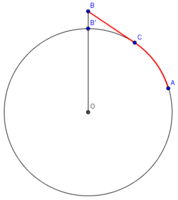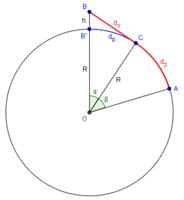It's been a little too long since I have been in school so I'm hoping someone whose mind is still fresh with math can answer this with ease compared to me.
Imagine you have two points on the Earth where one is at an elevation, perhaps on a hill or mountain, while the other may or may not be above ground level.
The shortest path in that case would be partly a great circle (assuming the points were far enough apart) and partly a straight line. One way to imagine this is to think of a piece of string stretched, say about a foot long, and then taking a tennis ball and pushing it up into the string at some point along it. Now part of the string is wrapped around the ball and part of it is straight. For my purposes I'm only concerned with points on the Earth so the tennis ball analogy is a little off but hopefully it serves as a mental visual aid.
Does anyone know a formula that would calculate the distance between two points on a sphere where they may not be at the surface of the sphere so that we take into account both the great circle part and the straight part(s) of the path given two coordinates both of the form x,y,z and a radius for the sphere? We can ignore that the Earth is a spheroid for this purpose.
Thanks!
Reg
Imagine you have two points on the Earth where one is at an elevation, perhaps on a hill or mountain, while the other may or may not be above ground level.
The shortest path in that case would be partly a great circle (assuming the points were far enough apart) and partly a straight line. One way to imagine this is to think of a piece of string stretched, say about a foot long, and then taking a tennis ball and pushing it up into the string at some point along it. Now part of the string is wrapped around the ball and part of it is straight. For my purposes I'm only concerned with points on the Earth so the tennis ball analogy is a little off but hopefully it serves as a mental visual aid.
Does anyone know a formula that would calculate the distance between two points on a sphere where they may not be at the surface of the sphere so that we take into account both the great circle part and the straight part(s) of the path given two coordinates both of the form x,y,z and a radius for the sphere? We can ignore that the Earth is a spheroid for this purpose.
Thanks!
Reg
Last edited:


